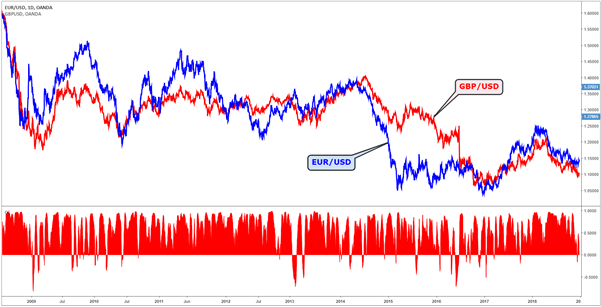Forex Analysis me Correlation:-
the Forex market evaluation mein correlation ka istemaal karke buyers aur buyers currencies ke motion ko samajhne ki Correlation ka major faida ye hai ke isay samajhna asaan hai aur iska istemal karne mein kaaragar hai. Double exchange yaani ke do currency pairs ya property ko robust fantastic correlation ke sath ek sath na khareedain ya bechein, is chance se bachne ka ek tareeqa hai.Lekin nuksan ke liye, buyers ke sath sath statisticians bhi is device ka istemal karte waqt ghaltiyan karte hain, jo iske drawbacks se judi hainPehli baat to ye hai ke correlation coefficient cause-and-impact relation ko mirror nahi karta. Is wajah se ye saaf nahi ho sakta ke aik currency pair doosre ke motion ko lead karta hai ya ulta. Ye sirf correlation ka such hai. Kisi ko nahi pata ke iski wajah kya hai.Dusri baat hai, time ke andar taqatwar mawafiqat. Aaj taalluq hai, kal nahi. Intraday investors ke liye, ye unke mkoshish karte hain. Correlation, do ya zyada financial instruments ke expenses ke beech mein kisi bhi tarah ke sambandh ka measure hai. Yadi do currencies ke costs mein robust nice correlation hai, toh jab ek foreign money badhegi, dusri bhi badhegi, aur jab ek giregi, dusri bhi giregi. Jabki negative correlation mein, ek foreign money badhti hai toh dusri girti hai, aur vice versa.Forex marketplace mein, kuch currencies strong correlation mein hoti hain, jabki kuch vulnerable ya negligible correlation mein hoti hain. Ye correlation buyers ko market tendencies aur feasible charge moves ke bare mein insights pradan karta hai.

Forex Correlation Kahan Se Aati Hai?

Iski ek wajah alag currencies ko mutasir karne wale factors ki similarity hai. Misal ke tor par, agar aap EUR/USD aur GBP/USD pairs le lain, toh unka fantastic correlation hoga, jo ke is baat ki wajah se hai ke euro aur pound dono European currencies hain, jo aksar American currency ke khilaf mushabeha taur par pesh aati hain. Is tarah, jab "Europeans" ke liye financial scenario behtar hoti hai, toh both euro aur pound greenback ke khilaf barh jate hain.Ye bad correlation ke liye bhi sahi hai. For example, agar hum EUR/USD aur USD/CHF pairs dekhein, toh humein ye dekhne ko milega ke pehle pair mein European forex base currency hai, jabke doosre mein situation ulta hai: dollar base currency hai aur franc quote forex hai. Bilkul is wajah se humein currencies ka inverse correlation milta haiTeesra tareeqa trades ki hedging ka hai. Agar do assets ke darmiyan taqatwar terrible correlation ho, toh aik ko khareedna aur foran doosra bechna nuksan ko kam kar sakta hai, lekin munafa, beshak, kam ho ga.
.
the Forex market evaluation mein correlation ka istemaal karke buyers aur buyers currencies ke motion ko samajhne ki Correlation ka major faida ye hai ke isay samajhna asaan hai aur iska istemal karne mein kaaragar hai. Double exchange yaani ke do currency pairs ya property ko robust fantastic correlation ke sath ek sath na khareedain ya bechein, is chance se bachne ka ek tareeqa hai.Lekin nuksan ke liye, buyers ke sath sath statisticians bhi is device ka istemal karte waqt ghaltiyan karte hain, jo iske drawbacks se judi hainPehli baat to ye hai ke correlation coefficient cause-and-impact relation ko mirror nahi karta. Is wajah se ye saaf nahi ho sakta ke aik currency pair doosre ke motion ko lead karta hai ya ulta. Ye sirf correlation ka such hai. Kisi ko nahi pata ke iski wajah kya hai.Dusri baat hai, time ke andar taqatwar mawafiqat. Aaj taalluq hai, kal nahi. Intraday investors ke liye, ye unke mkoshish karte hain. Correlation, do ya zyada financial instruments ke expenses ke beech mein kisi bhi tarah ke sambandh ka measure hai. Yadi do currencies ke costs mein robust nice correlation hai, toh jab ek foreign money badhegi, dusri bhi badhegi, aur jab ek giregi, dusri bhi giregi. Jabki negative correlation mein, ek foreign money badhti hai toh dusri girti hai, aur vice versa.Forex marketplace mein, kuch currencies strong correlation mein hoti hain, jabki kuch vulnerable ya negligible correlation mein hoti hain. Ye correlation buyers ko market tendencies aur feasible charge moves ke bare mein insights pradan karta hai.

Forex Correlation Kahan Se Aati Hai?
Iski ek wajah alag currencies ko mutasir karne wale factors ki similarity hai. Misal ke tor par, agar aap EUR/USD aur GBP/USD pairs le lain, toh unka fantastic correlation hoga, jo ke is baat ki wajah se hai ke euro aur pound dono European currencies hain, jo aksar American currency ke khilaf mushabeha taur par pesh aati hain. Is tarah, jab "Europeans" ke liye financial scenario behtar hoti hai, toh both euro aur pound greenback ke khilaf barh jate hain.Ye bad correlation ke liye bhi sahi hai. For example, agar hum EUR/USD aur USD/CHF pairs dekhein, toh humein ye dekhne ko milega ke pehle pair mein European forex base currency hai, jabke doosre mein situation ulta hai: dollar base currency hai aur franc quote forex hai. Bilkul is wajah se humein currencies ka inverse correlation milta haiTeesra tareeqa trades ki hedging ka hai. Agar do assets ke darmiyan taqatwar terrible correlation ho, toh aik ko khareedna aur foran doosra bechna nuksan ko kam kar sakta hai, lekin munafa, beshak, kam ho ga.
.

تبصرہ
Расширенный режим Обычный режим